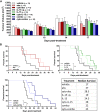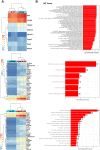Targeting Prostate Cancer Using Intratumoral Cytotopically Modified Interleukin-15 Immunotherapy in a Syngeneic Murine Model
- PMID: 32802803
- PMCID: PMC7394845
- DOI: 10.2147/ITT.S257443
Targeting Prostate Cancer Using Intratumoral Cytotopically Modified Interleukin-15 Immunotherapy in a Syngeneic Murine Model
Abstract
Background: The prostate cancer microenvironment is highly immunosuppressive; immune cells stimulated in the periphery by systemic immunotherapies will be rendered inactive once entering this environment. Immunotherapies for prostate cancer need to break this immune tolerance. We have previously identified interleukin-15 (IL-15) as the only cytokine tested that activates and expands immune cells in the presence of prostate cancer cells. In the current study, we aimed to identify a method of boosting the efficacy of IL-15 in prostate cancer.
Methods: We engineered, by conjugation to a myristoylated peptide, a membrane-localising form of IL-15 (cyto-IL-15) and the checkpoint inhibitor antibodies cytotoxic T lymphocyte antigen 4 (CTLA-4) and programmed death ligand 1 (PD-L1) (cyto-abs) to enable them to bind to cell surfaces by non-specific anchoring to the phospholipid bilayer. The efficacy of these agents was investigated by intratumoral administration either alone (cyto-IL-15 or cyto-abs) or in combination (cyto-combo) in subcutaneous TRAMP-C2 prostate tumors in C57BL/6J mice and compared with their non-modified equivalents in vivo. Following the survival endpoint, histological analyses and RNA sequencing were performed on the tumors.
Results: Intratumoral injection of cyto-IL-15 or cyto-combo delayed tumor growth by 50% and increased median survival to 28 and 25 days, respectively, compared with vehicle (17 days), whereas non-modified IL-15 or antibodies alone had no significant effects on tumor growth or survival. Histological analysis showed that cyto-IL-15 and cyto-combo increased necrosis and infiltration of natural killer (NK) cells and CD8 T cells in the tumors compared with vehicle and non-modified agents. Overall, the efficacy of cyto-combo was not superior to that of cyto-IL-15 alone.
Conclusion: We have demonstrated that intratumoral injection of cyto-IL-15 leads to prostate cancer growth delay, induces tumor necrosis and increases survival. Hence, cytotopic modification in combination with intratumoral injection appears to be a promising novel approach for prostate cancer immunotherapy.
Keywords: IL-15; NK cells; checkpoint blockade; cytotopic modification; prostate cancer.
© 2020 Papaevangelou et al.
Conflict of interest statement
Efthymia Papaevangelou, Dorota Smolarek, Richard A Smith, Prokar Dasgupta, and Christine Galustian report a patent, GB 1,913,804.9, pending to King's College London and the Prostate Cancer Research Centre Charity. The authors report no other possible conflicts of interest in this work.
Figures






Similar articles
-
Cyto-IL-15 synergizes with the STING agonist ADU-S100 to eliminate prostate tumors and confer durable immunity in mouse models.Front Immunol. 2023 Jul 3;14:1196829. doi: 10.3389/fimmu.2023.1196829. eCollection 2023. Front Immunol. 2023. PMID: 37465665 Free PMC article.
-
Cytotopic (Cyto-) IL-15 as a New Immunotherapy for Prostate Cancer: Recombinant Production in Escherichia coli and Purification.Front Mol Biosci. 2021 Oct 27;8:755764. doi: 10.3389/fmolb.2021.755764. eCollection 2021. Front Mol Biosci. 2021. PMID: 34778376 Free PMC article.
-
Simultaneous inhibition of two regulatory T-cell subsets enhanced Interleukin-15 efficacy in a prostate tumor model.Proc Natl Acad Sci U S A. 2012 Apr 17;109(16):6187-92. doi: 10.1073/pnas.1203479109. Epub 2012 Apr 2. Proc Natl Acad Sci U S A. 2012. PMID: 22474386 Free PMC article.
-
IL-15 in the Combination Immunotherapy of Cancer.Front Immunol. 2020 May 19;11:868. doi: 10.3389/fimmu.2020.00868. eCollection 2020. Front Immunol. 2020. PMID: 32508818 Free PMC article. Review.
-
Therapeutic gene modified cell based cancer vaccines.Gene. 2013 Aug 10;525(2):200-7. doi: 10.1016/j.gene.2013.03.056. Epub 2013 Apr 6. Gene. 2013. PMID: 23566846 Review.
Cited by
-
What Do We Have to Know about PD-L1 Expression in Prostate Cancer? A Systematic Literature Review. Part 4: Experimental Treatments in Pre-Clinical Studies (Cell Lines and Mouse Models).Int J Mol Sci. 2021 Nov 14;22(22):12297. doi: 10.3390/ijms222212297. Int J Mol Sci. 2021. PMID: 34830179 Free PMC article.
-
What Do We Have to Know about PD-L1 Expression in Prostate Cancer? A Systematic Literature Review. Part 5: Epigenetic Regulation of PD-L1.Int J Mol Sci. 2021 Nov 15;22(22):12314. doi: 10.3390/ijms222212314. Int J Mol Sci. 2021. PMID: 34830196 Free PMC article.
-
Radioenhancement with the Combination of Docetaxel and Ultrasound Microbubbles: In Vivo Prostate Cancer.Pharmaceutics. 2023 May 11;15(5):1468. doi: 10.3390/pharmaceutics15051468. Pharmaceutics. 2023. PMID: 37242710 Free PMC article.
-
The role of proinflammatory cytokines and CXC chemokines (CXCL1-CXCL16) in the progression of prostate cancer: insights on their therapeutic management.Cell Mol Biol Lett. 2024 May 14;29(1):73. doi: 10.1186/s11658-024-00591-9. Cell Mol Biol Lett. 2024. PMID: 38745115 Free PMC article. Review.
-
Cyto-IL-15 synergizes with the STING agonist ADU-S100 to eliminate prostate tumors and confer durable immunity in mouse models.Front Immunol. 2023 Jul 3;14:1196829. doi: 10.3389/fimmu.2023.1196829. eCollection 2023. Front Immunol. 2023. PMID: 37465665 Free PMC article.
References
LinkOut - more resources
Full Text Sources
Research Materials
Miscellaneous

